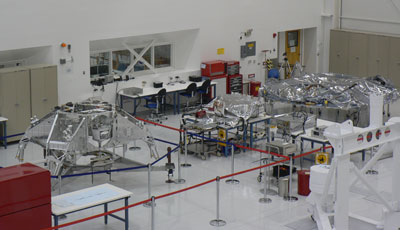Don’t forget the robotsby Taylor Dinerman
|
| Yet, given the investment that has been made in the program, why is MSL limited to just one lander? |
The Mars Science Laboratory (MSL), which was originally supposed to be launched in the fall of 2009—or about now—will not take off until October or November of 2011. The delays and cost overruns have badly impacted other planetary science programs. This is a prime example of why the former head of the NASA Science Mission Directorate, Alan Stern, has complained that good programs—ones that keep within their budgets—are made to pay for the ones that don’t.
This is not to say that the MSL (recently renamed Curiosity) is not worthwhile: if it does work as promised it will take our knowledge of Mars to a whole new level. Yet, given the investment that has been made in the program, why is it limited to just one lander? Surely, if the technology and the science are worth the effort, a second MSL mission would seem to be a good way to maximize the return on NASA’s investment.
The array of probes and rovers that have been studying the Red Planet intensively since Mars Pathfinder landed in 1997 are showing their age. Gallant little Spirit is still stuck. The folks at the Jet Propulsion Lab (JPL) in Pasadena might pull off something close to a miracle and get it moving again, but the odds seem to be getting longer. Its twin, Opportunity, is continuing its mission but after nearly six years it may not make it till 2012 when Curiosity is expected to arrive.
Around Mars NASA’s Mars Odyssey, launched on April 2001, is still operational. The Mars Reconnaissance Orbiter (MRO) launched in 2005 is having trouble, but the team at JPL may be able to fix it and continue the mission. Europe’s Mars Express is also circling the planet. In spite of the problems with Curiosity, NASA has committed to a series of Mars missions, as well as a promise to support a pair of European Mars missions. Keeping these programs on time and within budget will be a challenge.
One hopeful development is the planned launch of the medium-sized Juno probe to Jupiter’s poles in August 2011. The more ambitious Outer Planets Flagship mission that NASA hopes to launch sometime in the middle of the next decade is going to be more difficult to get off the ground due to budget problems and also due to Congressional reluctance to fund development of the plutonium needed for the radioisotope thermoelectric generators that power such missions.
| Everyone at NASA may suddenly become aware that their fates are all wrapped up with each other. It will be a painful and costly lesson. |
As Mike Griffin pointed out in Congressional testimony in September, NASA’s budget has been reduced by more than 20% in real terms in the last 15 years. The agency’s technology development programs and its aviation programs have been cut to the bone. Future cuts, even if they are aimed at the human spaceflight program, will inevitably hit the science directorate.
As Norman Augustine explained, the Shuttle program’s budget has for many years covered a huge chunk of NASA overhead expenses. Once the last flight has returned to Earth, those costs will have to be paid for by other parts of the budget. The science community will be expected to pick up a share. This will add to the overall cost of every single mission.
Sean O’Keefe tried, with indifferent success, to promote a “One NASA” attitude in the agency. It was a nice idea, but inside an organization filled with smart and highly driven people it was an impossible dream. However, everyone at NASA may suddenly become aware that their fates are all wrapped up with each other. It will be a painful and costly lesson.
